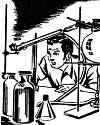 In 1928, Dr. Carothers, working in a laboratory in Wilmington,
took a different approach. Instead of trying to duplicate the silk
fiber, he started by analyzing the job to be done. What were the
results desired? He found that the qualities people liked in silk were
its appearance, resilience and wearing qualities.
In 1928, Dr. Carothers, working in a laboratory in Wilmington,
took a different approach. Instead of trying to duplicate the silk
fiber, he started by analyzing the job to be done. What were the
results desired? He found that the qualities people liked in silk were
its appearance, resilience and wearing qualities. From this analysis, he tried many combinations until one day, some years later, he chemically produced a coarse, tough fiber from which he was able to draw some very fine filaments through a hypodermic needle. He had at last produced a fine synthetic fiber that was strong and resilient - it was not an imitation of silk, wool or cotton. It was an entirely new thing from which have been made numerous products from toothbrushes to nylon stockings. This is a brief history of just one element of the textile business but it is a good example of how progress is made. The new material broadens the field, the older ones are improved. |








